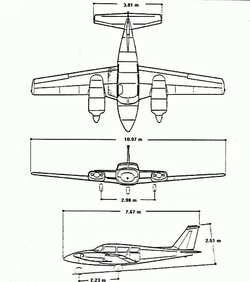Pilot Continued Flight Into Marginal VFR Conditions At
Night
The NTSB has found pilot error to be the cause of a fatal
accident which occurred about a year ago in the mountains of West
Virgina. The pilot, who had owned the Piper PA-30 Twin Comanche for
only about a month, impacted rising terrain in marginal VFR
conditions at night.

The NTSB's factual report indicates that the 52-year-old pilot
held a commercial pilot certificate issued on April 8, 2004, with
ratings for airplane single-engine land, airplane multiengine land,
helicopter, and instrument airplane. In addition, the pilot held a
second-class medical certificate, issued on October 2, 2009, with
no restrictions. The pilot indicated on his application for the
medical certificate that he had 1,575 total flight hours.
According to the probable cause report released late last
month:
"The pilot departed on the first of two flights toward his home
airport during day visual meteorological conditions. He stopped en
route about 4 hours later, then departed shortly before midnight
(accident time zone) toward his final destination in night visual
meteorological conditions. About 3 hours later, the airplane
impacted trees and rising terrain during night marginal visual
meteorological conditions.
"Radar data indicated that during the last 3 minutes of flight,
the airplane flew a serpentine course at varying low level
altitudes. On the morning before the accident, the pilot obtained a
computer-based weather briefing, which included deteriorating
weather conditions along the route, and instrument meteorological
conditions beyond the accident site. The pilot subsequently
received about 1 hour 30 minutes of dual instruction in the
newly-purchased airplane, and following that, the instructor
attempted to persuade him to spend the night. The pilot responded
that he didn't want to wait because of the deteriorating weather
along the latter part of his route, but agreed to stop overnight
along the way. The pilot later told another person that he would
continue to his destination.

"The time from when the pilot obtained a weather briefing until
the accident was about 16 hours; however, it is unknown if or when
the pilot may have rested, how fatigued he may have been, or if it
affected the outcome. Although the pilot held an instrument rating,
he had not flown in actual instrument conditions for about 18 years
prior to the accident. Post-accident examination of the airplane's
airframe, flight controls, propellers, engine assemblies and
accessories revealed no mechanical anomalies, and damage to the
propellers indicated that both engines were under power at impact.
The serpentine flight path and the wreckage path indicated the
likelihood that the airplane was in controlled flight when it
impacted the trees."
The NTSB determined that the probable cause of the accident to
be "(t)he pilot's improper decision to attempt visual flight into
deteriorating night weather conditions, and his subsequent
controlled flight into terrain."
 Classic Aero-TV: Remembering Bob Hoover
Classic Aero-TV: Remembering Bob Hoover ANN FAQ: Follow Us On Instagram!
ANN FAQ: Follow Us On Instagram! ANN's Daily Aero-Linx (05.15.24)
ANN's Daily Aero-Linx (05.15.24) ANN's Daily Aero-Term (05.15.24):Altimeter Setting
ANN's Daily Aero-Term (05.15.24):Altimeter Setting Aero-News: Quote of the Day (05.16.24)
Aero-News: Quote of the Day (05.16.24)




